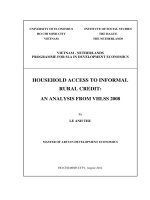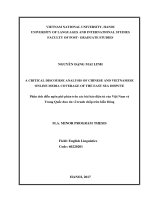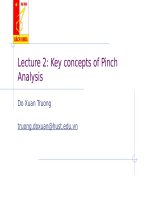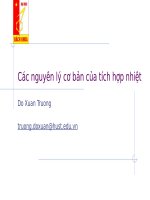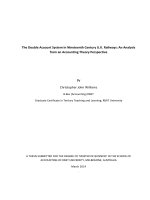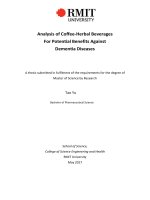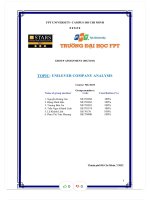Ch10 experimental modal analysis
Bạn đang xem bản rút gọn của tài liệu. Xem và tải ngay bản đầy đủ của tài liệu tại đây (604.34 KB, 62 trang )
10 Experimental modal analysis
10.1
Introduction
In almost every branch of engineering, vibration phenomena have always
been measured with two main objectives in mind: the first is to determine
the vibration levels of a structure or a machine under ‘operating’ conditions,
while the second is to validate theoretical models or predictions. Thanks to
the developments and advances in electronic instrumentation and computer
resources of recent decades, both types of measurements can now be
performed effectively; one should also consider that the increasing need for
accurate and sophisticated measurements has been brought about by the
design of lighter, more flexible and less damped structures, which are
increasingly susceptible to the action of dynamic forces.
Experimental modal analysis (EMA) is now a major tool in the field of
vibration testing. As such, it was first applied in the 1940s in order to gain
more insight in the dynamic behaviour of aircraft structures and, since then,
it has evolved through various stages where the terms of ‘resonance testing’
or ‘mechanical impedance’ were used to define this general area of activity.
Modal testing is defined as the process of characterizing the dynamic
behaviour of a structure in terms of its modes of vibration. More specifically,
EMA aims at the development of a mathematical model which describes the
vibration properties of a structure from experimental data rather than from
theoretical analysis; in this light, it is important to understand that a correct
approach to the experimental procedures can only be decided after the
objectives of the investigation have been specified in detail. In other words,
the right questions to ask are ‘What do we need to know? What is the desired
outcome of the experimental analysis?’ and ‘What are the steps that follow
the experimental test and for what reason are they undertaken?’. As often
happens in science and technology—and this easier said than done—posing
the problem correctly generally results in considerable savings in terms of
time and money. The necessity of stating the problem correctly is due to the
fact that modal testing can be used to investigate a large class of problems—
from finite-element model verification to troubleshooting, from component
substructuring to integrity assessment, from evaluation of structural
Copyright © 2003 Taylor & Francis Group LLC
modifications to damage detection and so forth—and therefore the final
goal has a significant influence on the practical aspects of what to do and
how to do it. Obviously, the type and size of structure under test also play
a major role in this regard.
Last but not least, it is worth noting that, on the experimenter’s part, a correct
approach to EMA requires a broad knowledge of many branches of engineering
which, traditionally, have often been considered as separate areas of activity.
If we now refer back to the introduction of Chapter 7, we can once again
adopt Ewins’ definitions and note that in this chapter we will proceed along
the ‘experimental route’ to vibration analysis which, schematically, goes
through the following three stages:
1. the measurement of the response properties of a given system;
2. the extraction of its modal properties (eigenfrequencies, eigenvectors and
modal damping ratios);
3. the definition of an appropriate mathematical model which, hopefully,
describes within a certain degree of accuracy some essential characteristics
of the original system and can be used for further analysis.
10.2 Experimental modal analysis—overview of the
fundamentals
In essence, EMA is the process by which an appropriate set of measurements
is performed on a given structure in order to extract information on its modal
characteristics, i.e. natural frequencies of vibration, mode shapes and damping
factors. Broadly speaking, the whole process can be divided into the three
main phases as defined in the preceding section, which can be synthetically
restated as:
1. data acquisition
2. modal parameters estimation
3. interpretation and presentation of results.
It is the author’s opinion that the most delicate phase is the first one. In fact,
no analysis can fix a set of poor experimental measurements, and it seldom
happens that the experimenter is given a second chance. By contrast, a good
set of experimental data can always be used more than once to go through
phases 2 and 3.
A modal analysis test is performed under a controlled forced vibration
condition, meaning that the structure is subject to a measurable force input
and its vibratory response output is measured at a number of locations which
identify the degrees of freedom of the structure. Three basic assumptions are
made on the structure to be tested:
Copyright © 2003 Taylor & Francis Group LLC
1. The structure is linear. This assumption means that the principle of
superposition holds; it implies that the structure’s response to a force input
is a linear combination of its modes and also that the structure’s response
to multiple input forces is the sum of the responses to the same forces
applied separately. In general, a wide class of structures behave linearly if
the input excitation is maintained within a limited amplitude range; hence,
during the test, it is important to excite the structure within this range.
For completeness of information, It must be pointed out that there
exists an area of activity called ‘nonlinear modal analysis’ whose main
objective is the same as for the linear case, i.e. to establish a mathematical
model of the structure under test from a set of experimental
measurements. In this case, however, the principle of superposition cannot
be invoked and the mathematical model becomes nonunique, being
dependent on vibration amplitude.
2. The structure is time invariant. This assumption means that the
parameters to be determined are constants and do not change with time.
The simplest example is a mass-spring SDOF system whose mass m and
spring stiffness k are assumed to be constant.
3. The structure is observable. This assumption means that the input-output
measurements to be made contain enough information to adequately
determine the system’s dynamics. Examples of systems that are not
observable would include structures or machines with loose components
(that may rattle) or a tank partially filled with a fluid that would slosh
during measurements: if possible, these complicated behaviours should
be eliminated in order to obtain a reliable modal model.
In addition to the assumptions above, most structures encountered in vibration
testing obey Maxwell’s reciprocity relations provided that the inputs and
outputs are not mixed. In other words, for linear holonomic-scleronomic
systems reciprocity holds if, for example, all inputs are forces and all outputs
are displacements (or velocities or accelerations); by contrast, reciprocity does
not apply if, say, some inputs are forces and some are displacements and if
some outputs are velocities and some are displacements. Unless otherwise stated,
we will assume in the following that reciprocity holds; for our purposes, the
main consequence of this assumption is that receptance, mobility, and
accelerance and impulse response functions matrices are all symmetrical.
Given the assumptions above, a modal test can be performed by proceeding
through phases 1–3. Since there is no such thing as ‘the right way’ valid for
all circumstances, each phase poses a number of specific problems whose
solutions depend, for the most part, on the final objectives of the investigation
and on the desired results.
In phase 1 the problem to be tackled has to do with the experimental setup and the questions to be answered are, for example: how many points
(degrees of freedom) are needed to achieve the desired result? how do we
excite the structure and how do we measure its response?
Copyright © 2003 Taylor & Francis Group LLC
In phase 2, on the other hand, the focus is on the specific technique to be
used in order to extract the modal parameters from the experimental
measurements. This task is now accomplished by means of commercial
software packages but the user, at a minimum, should at least have an idea
of how the various methods work in order to decide which technique may
be adopted for his/her specific application.
Finally, phase 3 has to do with the physical interpretation of results and
with their presentation in form of numbers, graphs, animations of the modal
shapes or whatever else is required for further theoretical analysis, if any is
needed.
10.2.1
FRFs of SDOF systems
With the exception of the available electronic instrumentation and the basic
concepts of digital signal analysis—which will be considered separately in
the final chapters of this book—most of the theoretical concepts needed in
EMA have been introduced and discussed in previous chapters (Chapters 4,
6 and 7) whose content is a prerequisite for the present developments.
Nevertheless, in the light of the fact that the first step in a large number of
experimental methods in modal analysis consists of acquiring an appropriate
set of frequency response functions (FRFs) of the system under investigation,
this section considers briefly some characteristics of these functions.
Consider, for example, the receptance function of an SDOF system whose
physical parameters are mass m stiffness k and damping coefficient c. From
eq (4.42) the magnitude of this FRF is given by
(10.1a)
or, alternatively (eq (4.44))
(10.1b)
where, as usual,
we
and
When or
have, respectively
(10.2a)
and
(10.3a)
Copyright © 2003 Taylor & Francis Group LLC
Owing to the wide dynamic range of FRFs, it is often customary to plot
the magnitude of FRF functions on log-log graphs or, more precisely, in dB
(where the reference value, unless otherwise stated, is unity); this circumstance
has also the additional advantage that data that plot as curves on linear
scales become asymptotic to straight lines on log scales and provide a simple
means for identifying the stiffness and mass of simple systems. In fact, eqs
(10.2a) and (10.3a) become, respectively
(10.2b)
and
(10.3b)
so that in the low-frequency part of the graph we have a horizontal spring
line and in the high-frequency part of the graph we have a mass line whose
slope is –40 dB/decade (–12.04 dB/octave, or a downward slope of –2 on a
log scale) and whose position is controlled by the value of m. The stiffness
and mass lines intersect at a point whose abscissa is the resonant frequency
of the system, i.e. when the spring and the inertia force cancel and only the
damping force is left to counteract the external applied force.
As an example, a graph of this kind is plotted in Fig. 10.1 for a system
with
and c=1200 N s/m (implying
and
note that, as expected, the stiffness line is
at –120 dB, meaning that
Fig. 10.1
Copyright © 2003 Taylor & Francis Group LLC
A similar line of reasoning applies to mobility and accelerance FRFs;
mobility graphs, for example, are symmetrical about the vertical axis at ωn;
in the low frequency range we note a stiffness line with an upward slope of
+20 dB/decade (+6.02 dB/octave, or +1 on a log scale) while in the highfrequency range there is a mass line with a downward slope of –20 dB/
decade (–1 on a log scale). Moreover, at resonance we get
(10.4)
implying that there is a horizontal line of viscous damping in the logarithmic
representation (in this regard, the reader can verify that a horizontal line of
hysteretic damping is obtained in receptance graphs).
By contrast, accelerance graphs display a stiffness line with an upward
slope of +40 dB/decade in the low-frequency range and a horizontal mass
line in the high frequency range. The graphs of mobility and accelerance for
the SDOF system considered above are shown in Figs 10.2 and 10.3.
Equation (10.1a) (or (10.1b)), however, does not tell the whole story.
Whether we consider an SDOF or an MDOF system, we know from previous
chapters that FRFs are complex functions and cannot be completely
represented on a standard x–y graph. The consequence is that there are three
widely adopted display formats:
•
The Bode diagram. This consists of two graphs which plot, respectively,
the FRF magnitude and phase as functions of frequency. The graph of
Fig. 10.2
Copyright © 2003 Taylor & Francis Group LLC
Fig. 10.3
•
•
magnitude versus frequency is usually displayed in log(y)–log(x) scales,
dB(y)–log(x) or dB(y)–linear(x) scales (but linear-linear scales are
sometimes used as well); in this regard it is worth noting that plotting
the amplitude ratio in dB on a linear scale is equivalent to plotting the
amplitude on a logarithmic scale.
The real and imaginary plots. These display the FRF real and imaginary
parts as functions of frequency.
The Nyquist diagram (or polar graph). This is a single plot which displays
the FRF imaginary part as a function of the real part (this format is
particularly useful in many circumstances, but has the inconvenience of
not showing explicitly the frequency information (Fig. 4.14); this
information can be given by adding captions which indicate the values
of frequency).
All of the above formats are generally available in commercial software
packages.
In the Bode diagrams, the graphs of phase angles may sometimes be a
source of confusion. If we adopt the phasor representation of rotating
vectors (Chapter 1), we have stated on a few occasions that, provided that
consistency is maintained, it is somewhat irrelevant to choose the convention
(clockwise rotating vector) or
(counterclockwise rotating vector).
However, if the forcing function is written as
it is customary (eq
(4.41)) to write the displacement response as
so that φ, when
Copyright © 2003 Taylor & Francis Group LLC
Fig. 10.4
Copyright © 2003 Taylor & Francis Group LLC
Fig. 10.4 (continued)
plotted as in Fig. 4.9, is to be understood as the angle of lag of displacement
behind the external force, the two extreme situations being as follows:
•
•
When
When
the displacement is in phase with the force and
the displacement lags behind the force of π radians and
By the same token, velocity is written as
where φ v is the
angle of lag of velocity behind force and is given by
since we
know that velocity leads displacement by π/2 radians. When
velocity
leads force by π/2 so that the velocity angle of lag behind force is
on the other hand, when
Similar considerations apply for
the acceleration phase angle
which ranges from
–π (
) to zero (
) radians. In brief, in the negative exponential
convention the phase angle is positive when it is an angle of lag, negative
when it is an angle of lead and for an SDOF system all phase angles plotted
as functions of frequency are monotonically increasing functions. The same
situation arises if we adopt the positive exponential convention but we write
displacement, velocity and acceleration as
and
respectively.
Copyright © 2003 Taylor & Francis Group LLC
Fig. 10.5
Copyright © 2003 Taylor & Francis Group LLC
By contrast, in the positive exponential convention, displacement, velocity
and acceleration are sometimes written as
and
respectively, so that the phase angles must be accompanied
by a minus sign when they represent angles of lag. In this light, we have that
φ ranges from zero
,ranges from π /2 to
ranges from π to zero, and all phase angles
plotted as functions of frequency are monotonically decreasing functions.
Obviously, whatever convention we choose, it must be consistent with
the physical fact that—in steady-state conditions—displacement is in phase
with force when
, velocity is in phase with force at resonance, acceleration
is in phase with force when
and that, in all cases, velocity leads
displacement by π and acceleration leads velocity by π /2.
In order to illustrate this situation, Figs. 10.4(a), (b) and (c) show,
respectively, the Bode diagrams of receptance, mobility and accelerance of
the viscously damped SDOF system considered before. Those readers who
are familiar with the MATLAB® environment have certainly noticed that
these graphs have been drawn by using the ‘Bode’ command of MATLAB®.
Magnitude graphs are the same as Figs. 10.1, 10.2 and 10.3 and the label
‘Gain’ on the y-axis comes from the terminology commonly adopted in the
electrical engineering community.
The characteristic features of real and imaginary plots are that the real
part of the receptance and accelerance has a zero crossing at the resonant
frequency, while that of the mobility has a peak at resonance. On the other
hand, the imaginary part of the receptance and accelerance has a peak at
resonance, while that of the mobility has a zero crossing. Referring once
again to the SDOF system considered before in this section, examples of
such plots are shown in Figs. 10.5(a) and (b) (receptance), 10.6(a) and (b)
(mobility) and 10.7(a) and (b) (accelerance).
Finally, the Nyquist plots for the same SDOF system are shown in Figs.
10.8–10.10. All these graphs have been drawn in the frequency range 0–400
rad/s with a frequency spacing of
rad/s, meaning that we have
used 800 frequency lines to cover the whole range; the ‘+’ markers on the
curves identify these sampled frequency values. Since modern electronic
instrumentation converts analogue signals into digital ‘sampled’ signals at
an early stage of the measuring process (Chapters 13–15), the markers on
the curves below might represent actual data from acquired FRFs.
Note that, on the curves, data points away from resonance are very close
together (the markers overlap) while the arc spacing between markers becomes
larger and larger as we approach the resonant region. This is an advantage
and a disadvantage at the same time: the advantage is due to the fact that the
resonant frequency can be identified on these graphs with good accuracy
(i.e. better than other methods) by considering the maximum rate of change
of arc length as a function of frequency, while the disadvantage is that for
very lightly damped structures the typical circular shape may be lost if the
number of frequency lines is insufficient. An example of this situation is
Copyright © 2003 Taylor & Francis Group LLC
Fig. 10.6
Copyright © 2003 Taylor & Francis Group LLC
Fig. 10.7
Copyright © 2003 Taylor & Francis Group LLC
Fig. 10.8
Fig. 10.9
shown in Fig. 10.11, where the SDOF system considered in this case has
the same stiffness and mass as before, but it is much less damped (c=100
N s/m, i.e.)
and we have used 200 spectral lines to cover the
range 0–400 rad/s (i.e. the markers are
rad/s apart).
Copyright © 2003 Taylor & Francis Group LLC
Fig. 10.10
Fig. 10.11
From Figs 10.8–10.10, it is evident that the characteristic feature of Nyquist
plots is to enhance the resonance region with a nearly circular shape which
corresponds to the phase shift that the output undergoes with respect to the
input. However, for a viscously damped system it must be noted that only
Copyright © 2003 Taylor & Francis Group LLC
mobility traces out an exact circle (see also eqs (4.95), (4.96) and (4.97)),
while receptance and accelerance curves are distorted circles and tend to
become more distorted as damping is increased. Figures 10.12–10.14 illustrate
this situation: stiffness and mass are as before, but now c=4000 N s/m, i.e.
Also note that in this case the graphs have been drawn in the range
0–400 rad/s by using only 200 spectral lines and no information is lost on
the shape of the curves.
Finally, from the graphs of mobility of Figs 10.9 and 10.13 we can easily
obtain the value of viscous damping. In fact, eq (4.97) shows that the diameter
D of the mobility circle is 1/c, observing that
in Fig. 10.9
and
in Fig. 10.13 we get, as expected, c=1200 N s/m in the
first case and c=4000 N s/m in the second case.
It is left to the reader to show that for a hysteretically damped system it
is receptance that traces out an exact circle with centre at (0, 1/(2kγ)) and
diameter
As a hint, define
and note that
(10.5)
As an example, Fig. 10.15 shows the Nyquist plot of the FRF receptance
(10.6)
Fig. 10.12
Copyright © 2003 Taylor & Francis Group LLC
Fig. 10.13
Fig. 10.14
which represents a hysteretically damped SDOF system with k=1×106 N/m,
m=50 kg,
(i.e.
); as expected, the diameter of the
circle is
The graph covers the frequency range 0–400 rad/
s using 400 frequencies and it is worth noting that we have adopted the
negative exponential notation—i.e. the FRF is in the form of eq (4.72). The
reader is also invited to verify that, in this case, the positive exponential
notation leads to a Nyquist circle with centre at
Copyright © 2003 Taylor & Francis Group LLC
Fig. 10.15
10.2.2
FRFs of MDOF systems
Most of the considerations of the preceding section retain their validity when
we turn our attention to FRFs of MDOF systems. However, some new features
which have no counterpart in the SDOF case must be considered. The subject
will be, for the most part, discussed qualitatively, with the intention of
providing a general idea from an experimenter’s point of view. In fact, during
the data acquisition phase of a modal test—unless it is a laboratory test—
there is generally not much time for detailed quantitative considerations;
nonetheless, it is of fundamental importance to collect a ‘good’ set of data
(typically FRFs) whose quality and consistency can often by be rapidly
checked by a careful visual inspection.
For a n-DOF structure the main distinction that can be made is between
point (or driving) FRFs and transfer FRFs: a point FRF is a function of the type
meaning that the input and output are measured at the same point on
the structure, while a transfer FRF is a function of the type
with
Whenever appropriate, both point and transfer FRFs can be further subdivided
into direct and cross FRFs: the term direct meaning that both input and output
are measured along the same direction and the term cross meaning that input
and output are measured along different directions.
To make things clearer, suppose that we decided to test a given structure by
taking measurements at two points—point 1 and point 2—along both the x
Copyright © 2003 Taylor & Francis Group LLC
and y directions (the structure, for example, could be a beam with rectangular
cross section, z being the longitudinal direction of the beam). Either:
1. we can perform two separate tests, one in the x direction and one in
the y direction—and in both cases we would be dealing with a 2-DOF
system, or
2. we can perform a single test in which the x and y directions are considered
together, and in this case we would be dealing with a 4-DOF system.
If all FRFs are measured, each test of option 1 results in two direct point
FRFs (H11 and H22) and two direct transfer FRFs (H12 and H21). Strictly
speaking, no distinction between direct and cross FRFs is needed because no
cross FRFs exist in this case. By contrast, in option 2 we would have four
direct point FRFs (input and output measured in the same point along the
same direction), four direct transfer FRFs (input and output at different points
along the same direction), four cross point FRFs (input and output at the
same point along different directions) and four cross transfer FRFs (input
and output at different points along different directions). In this case, it is
convenient to number the degrees of freedom from 1 to 4 referring, for
example, to DOFs 1 and 2 for the measurements at point 1 and 2, respectively,
along the x direction and to DOFs 3 and 4 for the measurements at points
1 and 2 along the y direction. With these definitions, the dynamic behaviour
of the structure is described by the 4×4 matrix
(10.7)
where the direct point FRFs are on the main diagonal, the cross transfer FRFs
are on the secondary diagonal, the direct transfer FRFs are the elements H12,
H21, H34 and H43, and the remaining elements are the cross point FRFs.
In general, the most common situation in experimental tests is the case of
MDOF systems in which input and output are measured in the same direction
(i.e. a test of type 1, where no cross FRFs are acquired); for this reason, in
this section we will focus our attention on such tests.
In order to examine the main characteristics of FRFs of MDOF systems,
it will suffice for our purposes to consider the 2-DOF system of Section 7.9,
because all the considerations that follow can be extended in a straightforward
manner to systems with more than two degrees of freedom.
As expected, all graphs of magnitude versus frequency show two peaks
which occur at the resonant frequencies of our system. However, we have
already pointed out (Section 7.9) the appearance, between resonances, of an
Copyright © 2003 Taylor & Francis Group LLC
‘inverted peak’ of antiresonance in the point FRFs R11(ω) and R22(ω). No
such antiresonance exists in the magnitude graphs of the transfer FRFs R12(ω)
and R21(ω). Moreover, it is interesting to note that a phase shift of 180° not
only occurs at each resonance, but also at each (one in our case) antiresonance.
As a rule, point FRFs must have antiresonances between resonances; by
contrast, transfer FRFs may or may not have an antiresonance between two
neighbouring resonances. In general, all that can be said in this latter case is
that transfer FRFs corresponding to two points which are relatively close
together on the structure will show more antiresonances than FRFs
corresponding to points that are further apart on the structure. Let us
investigate these statements in more detail.
For an undamped n-DOF system, it was shown in Chapter 7 that a general
receptance FRF is written as
(10.8)
(see eq (7.28), where all
) where pjm is the jth element of the mth
eigenvector. For a point FRF j=k, implying that all the coefficients
are positive. When
all terms of the sum (10.8) are positive and the
response is generally dominated by the first term (which has the smallest
denominator). Right after the first resonance
the first term of
the sum still dominates but is now negative because its denominator is
negative; hence Rjj becomes negative and this change of sign corresponds to
the phase shift of 180°. As we move towards ω 2, there will be a value of
frequency at which the sum of all (positive) terms other than the first will
exactly cancel out the contribution of the first term so that the magnitude at
this point will be exactly zero. This is the antiresonance. As we pass this
point and move towards values of increasing frequency, the sum (10.8)
becomes positive again and this second change of sign at antiresonance
corresponds to another 180° phase shift. Then—until the last resonance—
the whole process repeats again and again as we keep moving in the direction
of increasing frequencies.
If
—depending on the type of structure and on the physical distance
between point j and point k—the coefficients
and
do not
necessarily have the same sign and no antiresonance may occur between any
two neighbouring resonances; when point j and point k are close together
on the structure it is more likely that the coefficients have the same sign and
there will be an antiresonance. In our 2-DOF example (R12(ω ) and R21(ω ))
the two neighbouring coefficients have different signs and there is no
antiresonance between the two resonances.
Referring again to this 2-DOF system (Section 7.9), the graphs of mobilities
M11, M12 and accelerances A11, A12 are shown in Figs. 10.16–10.19: part (a)
of each figure plots the magnitude on dB(y)–linear(x) scales, while part (b)
plots the magnitude on dB(y)–log(x) scales. The reader is invited to draw the
Copyright © 2003 Taylor & Francis Group LLC
Fig. 10.16
graphs of M22 and A22 and the graphs of phase versus frequency; the phase
information in mobility and accelerance FRFs is the same as in receptance
FRFs, measuring velocity or acceleration rather than displacement merely
introduces an offset of 90° or 180°.
For completeness, we also show in Figs 10.20 and 10.21 the graphs of
receptances R11 and R12 on dB(y)–log(x) scales (in Chapter 7 these graphs
were drawn only on dB(y)–linear(x) scales).
Copyright © 2003 Taylor & Francis Group LLC
Fig. 10.17
Although this may not be immediately evident in our example, a visual
comparison of the log-log graphs above also shows that resonances at higher
frequencies tend to exhibit less displacement than lower frequency resonances.
By contrast, the opposite situation occurs in accelerance graphs, which bias
magnitude in proportion to the second power of frequency. This suggests
that receptance may be the best choice if our attention is focused on lowfrequency modes, while accelerance is better for high-frequency modes.
Copyright © 2003 Taylor & Francis Group LLC
Fig. 10.18
However, when the frequency range of interest is relatively large, mobility
graphs make the best use of the available dynamic range (i.e. the vertical
space) because, broadly speaking, they give equal weight to all resonances in
the frequency range. In this regard, the reader can find a more detailed
explanation in Newland ([1], Chapter 3), where the ‘skeleton’ properties of
logarithmic response graphs are considered, the ‘skeleton’ consisting of a
sequence of straight line segments which change slope every time a resonance
or an antiresonance is crossed.
Copyright © 2003 Taylor & Francis Group LLC
Fig. 10.19
Sometimes, the readability of the graphs may be problematic if linear scales
are used. For example, higher-frequency resonances may hardly be noticed in
FRF receptance graphs of real and imaginary part versus frequency or in a
Nyquist plot, whereas low-frequency resonances may be difficult to see in
FRF accelerance graphs. Although this is not the case for our 2-DOF example,
the reader can have an idea by looking at Figs 10.22–10.24 which show,
Copyright © 2003 Taylor & Francis Group LLC
Fig. 10.20
Fig. 10.21
respectively, different display formats of the transfer FRFs R12, M12 and A12.
These figures also show the effect of different signs of the modal coefficients:
in the Nyquist plot, for example, the two loops are not in the same half of
the complex plane (as in point FRFs).
We close this section with two final observations. First, a careful inspection
of the mobility (receptance if we had considered a hysteretically damped
Copyright © 2003 Taylor & Francis Group LLC
